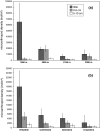Density and community structure of soil- and bark-dwelling microarthropods along an altitudinal gradient in a tropical montane rainforest
- PMID: 20229099
- PMCID: PMC2914295
- DOI: 10.1007/s10493-010-9348-x
Density and community structure of soil- and bark-dwelling microarthropods along an altitudinal gradient in a tropical montane rainforest
Abstract
Microarthropod communities in the soil and on the bark of trees were investigated along an elevation gradient (1,850, 2,000, 2,150, 2,300 m) in a tropical montane rain forest in southern Ecuador. We hypothesised that the density of microarthropods declines with depth in soil and increases with increasing altitude mainly due to the availability of resources, i.e. organic matter. In addition, we expected bark and soil communities to differ strongly, since the bark of trees is more exposed to harsher factors. In contrast to our hypothesis, the density of major microarthropod groups (Collembola, Oribatida, Gamasina, Uropodina) was generally low and decreased with altitude. However, as we predicted the density of each of the groups decreased with soil depth. Density of microarthropods on tree bark was lower than in soil. Overall, 43 species of oribatid mites were found, with the most abundant higher taxa being Poronota, pycnonotic Apheredermata, Mixonomata and Eupheredermata. The oribatid mite community on bark did not differ significantly from that in soil. The number of oribatid mite species declined with altitude (24, 23, 17 and 13 species at 1,850, 2,000, 2,150 and 2,300 m, respectively). Rarefaction curves indicate that overall about 50 oribatid mite species are to be expected along the studied altitudinal gradient. Results of this study indicate (1) that microarthropods may be limited by the quality of resources at high altitudes and by the amount of resources at deeper soil layers, and (2) that the bark of trees and the soil are habitats of similar quality for oribatid mites.
Figures




Similar articles
-
Oribatid mite communities along an elevational gradient in Sairme gorge (Caucasus).Exp Appl Acarol. 2015 May;66(1):41-51. doi: 10.1007/s10493-015-9893-4. Epub 2015 Mar 12. Exp Appl Acarol. 2015. PMID: 25761919
-
Community structure, trophic position and reproductive mode of soil and bark-living oribatid mites in an alpine grassland ecosystem.Exp Appl Acarol. 2010 Nov;52(3):221-37. doi: 10.1007/s10493-010-9366-8. Epub 2010 May 21. Exp Appl Acarol. 2010. PMID: 20490626 Free PMC article.
-
Trophic structure of a tropical soil- and litter-dwelling oribatid mite community and consistency of trophic niches across biomes.Exp Appl Acarol. 2019 May;78(1):29-48. doi: 10.1007/s10493-019-00374-4. Epub 2019 May 14. Exp Appl Acarol. 2019. PMID: 31089979
-
Soil Health and Arthropods: From Complex System to Worthwhile Investigation.Insects. 2020 Jan 16;11(1):54. doi: 10.3390/insects11010054. Insects. 2020. PMID: 31963103 Free PMC article. Review.
-
A global perspective on tropical montane rivers.Science. 2019 Sep 13;365(6458):1124-1129. doi: 10.1126/science.aax1682. Science. 2019. PMID: 31515386 Review.
Cited by
-
Drivers of Collembola assemblages along an altitudinal gradient in northeast China.Ecol Evol. 2022 Feb 12;12(2):e8559. doi: 10.1002/ece3.8559. eCollection 2022 Feb. Ecol Evol. 2022. PMID: 35169449 Free PMC article.
-
The joint effects of local, climatic, and spatial variables determine soil oribatid mite community assembly along a temperate forest elevational gradient.Ecol Evol. 2024 Jul 3;14(7):e11590. doi: 10.1002/ece3.11590. eCollection 2024 Jul. Ecol Evol. 2024. PMID: 38966244 Free PMC article.
-
Temporal fluctuations in oribatid mites indicate that density-independent factors favour parthenogenetic reproduction.Exp Appl Acarol. 2016 Apr;68(4):387-407. doi: 10.1007/s10493-015-0001-6. Epub 2016 Jan 6. Exp Appl Acarol. 2016. PMID: 26739694
-
Patterns of oribatid mite species diversity: testing the effects of elevation, area and sampling effort.Exp Appl Acarol. 2017 Jul;72(3):245-262. doi: 10.1007/s10493-017-0153-7. Epub 2017 Jul 17. Exp Appl Acarol. 2017. PMID: 28717996
-
Oribatid mite communities along an elevational gradient in Sairme gorge (Caucasus).Exp Appl Acarol. 2015 May;66(1):41-51. doi: 10.1007/s10493-015-9893-4. Epub 2015 Mar 12. Exp Appl Acarol. 2015. PMID: 25761919
References
-
- Adis J, de Morais JW, de Mesquita HG. Vertical distribution and abundance of arthropods in the soils of a neotropical secondary forest during the rainy season. Stud Neotrop Fauna Environ. 1987;22:189–197. doi: 10.1080/01650528709360733. - DOI
-
- Anderson JM. Succession, diversity and trophic relationships of some soil animals in decomposing leaf litter. J Animal Ecol. 1975;44:475–495. doi: 10.2307/3607. - DOI
-
- Bachmann S, Baker WJ, Brummitt N, Dransfield J, Moat J. Elevational gradients, area and tropical island diversity: an example from the palms of New Guinea. Ecography. 2004;27:299–310. doi: 10.1111/j.0906-7590.2004.03759.x. - DOI
-
- Beck L. Bodenzoologische Gliederung und Charakterisierung des amazonischen Regenwaldes. Amazoniana. 1971;3:69–132.
Publication types
MeSH terms
Substances
LinkOut - more resources
Full Text Sources

